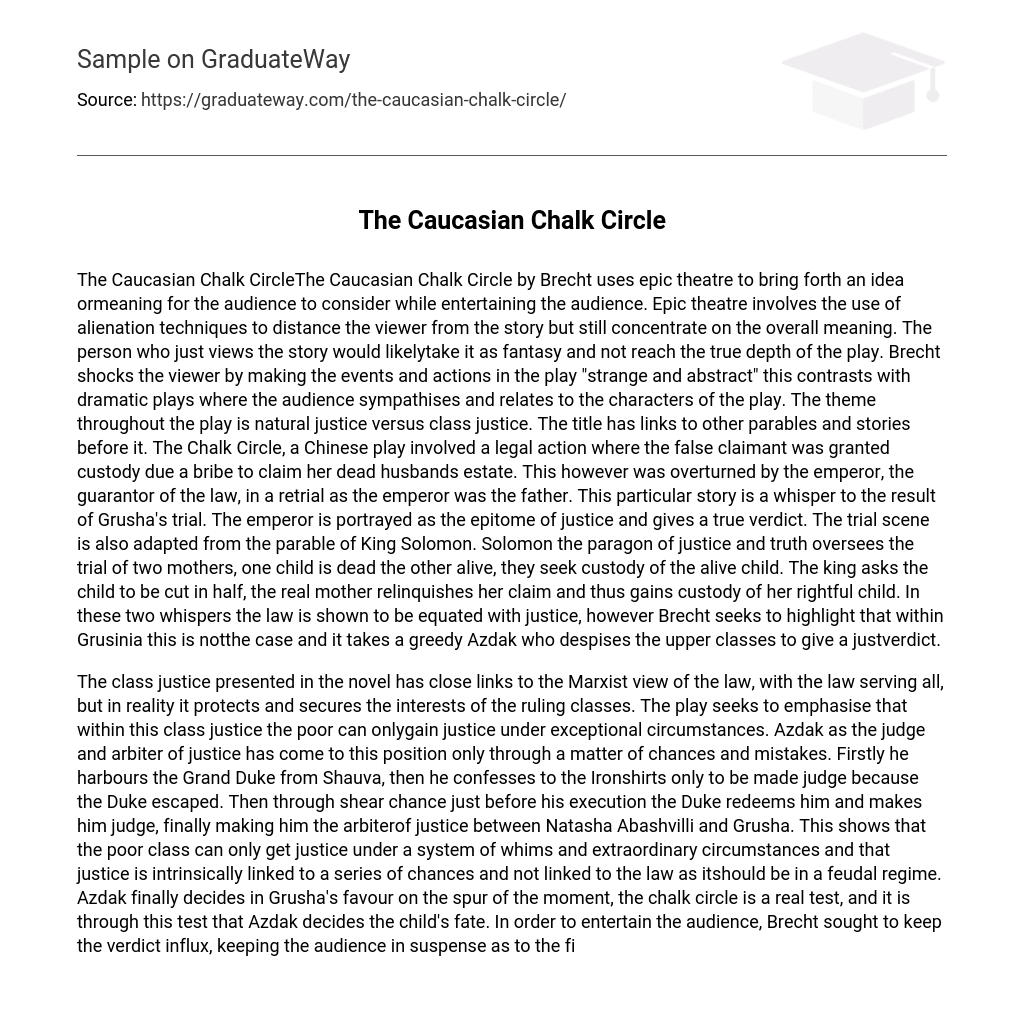The Caucasian Chalk CircleThe Caucasian Chalk Circle by Brecht uses epic theatre to bring forth an idea ormeaning for the audience to consider while entertaining the audience. Epic theatre involves the use of alienation techniques to distance the viewer from the story but still concentrate on the overall meaning. The person who just views the story would likelytake it as fantasy and not reach the true depth of the play. Brecht shocks the viewer by making the events and actions in the play “strange and abstract” this contrasts with dramatic plays where the audience sympathises and relates to the characters of the play. The theme throughout the play is natural justice versus class justice. The title has links to other parables and stories before it. The Chalk Circle, a Chinese play involved a legal action where the false claimant was granted custody due a bribe to claim her dead husbands estate. This however was overturned by the emperor, the guarantor of the law, in a retrial as the emperor was the father. This particular story is a whisper to the result of Grusha’s trial. The emperor is portrayed as the epitome of justice and gives a true verdict. The trial scene is also adapted from the parable of King Solomon. Solomon the paragon of justice and truth oversees the trial of two mothers, one child is dead the other alive, they seek custody of the alive child. The king asks the child to be cut in half, the real mother relinquishes her claim and thus gains custody of her rightful child. In these two whispers the law is shown to be equated with justice, however Brecht seeks to highlight that within Grusinia this is notthe case and it takes a greedy Azdak who despises the upper classes to give a justverdict.
The class justice presented in the novel has close links to the Marxist view of the law, with the law serving all, but in reality it protects and secures the interests of the ruling classes. The play seeks to emphasise that within this class justice the poor can onlygain justice under exceptional circumstances. Azdak as the judge and arbiter of justice has come to this position only through a matter of chances and mistakes. Firstly he harbours the Grand Duke from Shauva, then he confesses to the Ironshirts only to be made judge because the Duke escaped. Then through shear chance just before his execution the Duke redeems him and makes him judge, finally making him the arbiterof justice between Natasha Abashvilli and Grusha. This shows that the poor class can only get justice under a system of whims and extraordinary circumstances and that justice is intrinsically linked to a series of chances and not linked to the law as itshould be in a feudal regime. Azdak finally decides in Grusha’s favour on the spur of the moment, the chalk circle is a real test, and it is through this test that Azdak decides the child’s fate. In order to entertain the audience, Brecht sought to keep the verdict influx, keeping the audience in suspense as to the final outcome.
Azdak although seen as the arbiter of justice between Natasha Abashvilli and Grusha is shown throughout the play as greedy and corrupt when dealing with the upper classes. The humour that Azdak displays toward the upper class is entertaining, he constantly refers to them as “arse-holes.. sows.. well-born stinkers.” This anal imageryis continued right through the novel. Azdak is so disgusted by the odours the upper classes emit that he occasionally “before passing judgement, I went out and sniffed the roses.” This helps Azdak give the verdicts he gives to the “monied classes” such as the Invalid, and the landowner. He swindles them into giving him money for a bribe then turns about and gives a contradicting verdict against the upper classes. This duplicity when passing judgement is seen by the audience but the lower classes see that for once the law is on their side. This is the final hint that Grusha will get the child, as she isgood for the child and will continue to do good for the child, contrasting to Natasha Abashvilla’s intent to get the child only to keep her late husband’s estate. The singer sums up the meaning of the entire play, linking the prologue with the stories of Azdak and Grusha. “That what there is shall belong to those who are good for it,thus the children to the maternal, that they thrive; the carriages to good drivers, thatthey are driven well; and the valley to the waterers, that it shall bear fruit.” Brecht inthe play seeks to highlight the difference between justice and the law within Grusinia.The feudal society, or Marxist society, is shown to have harder implications for thepoor than the even distribution of wealth which is the main emphasis of the Marxiststate. The Marxist law is not equated with justice for all rather justice for the upperclasses, or class justice, where the rich get richer and the poor get poorer.





